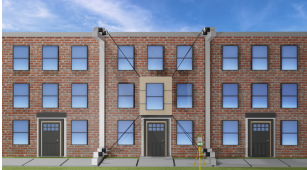2024-08-30 オークリッジ国立研究所(ORNL)
<関連情報>
- https://www.ornl.gov/news/automating-construction
- https://www.iaarc.org/publications/2024_proceedings_of_the_41st_isarc_lille_france/cable-driven_parallel_robot_cdpr_for_panelized_envelope_retrofits_feasible_workspace_analysis.html
パネル化されたエンベロープの改修のためのケーブル駆動パラレルロボット(CDPR): 実現可能な作業空間の分析 Cable-Driven Parallel Robot (CDPR) for Panelized Envelope Retrofits: Feasible Workspace Analysis
Yifang Liu, Rui Zhang, Nolan Hayes, Diana Hun, Bryan Maldonado
2024 Proceedings of the 41st ISARC
DOI:https://doi.org/10.22260/ISARC2024/0140

Abstract
Recent decades have seen remarkable progress in the field of robotic-assisted construction. Cable-driven parallel robots (CDPRs) emerge as promising tools for automating construction processes, due to their advantageous features such as scalability, reconfigurability, compact design, and high payload-to-weight ratio. This paper uses a simple static model to determine the feasibility of a CDPR for overclad panel installation in building envelope retrofits. Given that the building facade needs to be a subset of the CDPR’s wrench-feasible workspace, we focus on the sensitivity of the workspace concerning various cable arrangements and CDPR frame sizes (e.g., height and width extensions). Our analysis indicates that no cable arrangement satisfies the requirement of complete facade coverage and avoids cable-to-panel collisions. Thus, frame extension is needed to enhance coverage. However, in densely populated areas where width extension is limited by space constraints, height extension alone is insufficient to guarantee full facade coverage. This paper pioneers the investigation of CDPRs for panelized envelope retrofits, showcasing their advantages and limitations and paving the way for further research and development.



